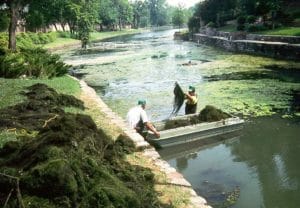Physical or mechanical aquatic weed removal can be part of an integrated pond management plan, but physical removal has limitations. It is best suited to very small ponds when there’s not much time available to clean up a weed-bound pond.
Over the years, various types of mechanical harvesters and “do-it-yourself” cutting tools have been developed for the lake management industry. Most of these are specialized devices which may not work in all situations. The most common are commercial harvesters which are used on large scale projects, such as temporarily clearing boat lanes or marinas on public reservoirs. These harvesters are expensive to operate and often kill juvenile fish that use the submersed weeds for protective cover.
The results of aquatic weed removal are short-lived

Manual Removal of Submersed Weeds
Most aquatic plants and algae reproduce through fragmentation. The biggest concern with physical removal is that the pieces of vegetation left behind provide a “jump start” for new growth. This is why state and federal fish and wildlife agencies stress careful cleaning of boats, trailers, and live wells when boating in lakes that contain exotic or invasive plant species.
Physical aquatic weed removal only removes the part of the plant above the pond bottom and leaves the roots intact. The results of physical removal are immediate, but very short-lived. This should be kept in mind when budgeting for long-term solutions to aquatic weed growth.
Physical removal can be an effective tool in small ponds if time is a factor. Many times, a pond owner has a special event planned where waiting 10-14 days for herbicide control is not acceptable. In these small ponds, algae or floating plants can be skimmed off of the surface for immediate results. However, this can be very labor intensive and disposal of the removed material is costly.
For longer lasting results, use EPA approved herbicides prior to physical removal
Manual cutting tools can be valuable to pond owners who wish to keep their portion of the shoreline manicured. Species such as cattails, reeds, and bulrushes can be periodically cut down to clear space for recreational uses of the pond. But, for best results, we always recommend herbicide application prior to physical removal. It’s important to wait approximately 45 days after the herbicide application before removing any dead, shoreline vegetation. This allows sufficient time for the herbicide to reach the roots of the plant.
We do not recommend controlling all shoreline, emergent plants since they do have benefits. In moderation, shoreline plants help stabilize soil and reduce erosion. They also provide habitat for fish and wildlife and also act as a riparian buffer, which plays a big role in improving overall water quality.
